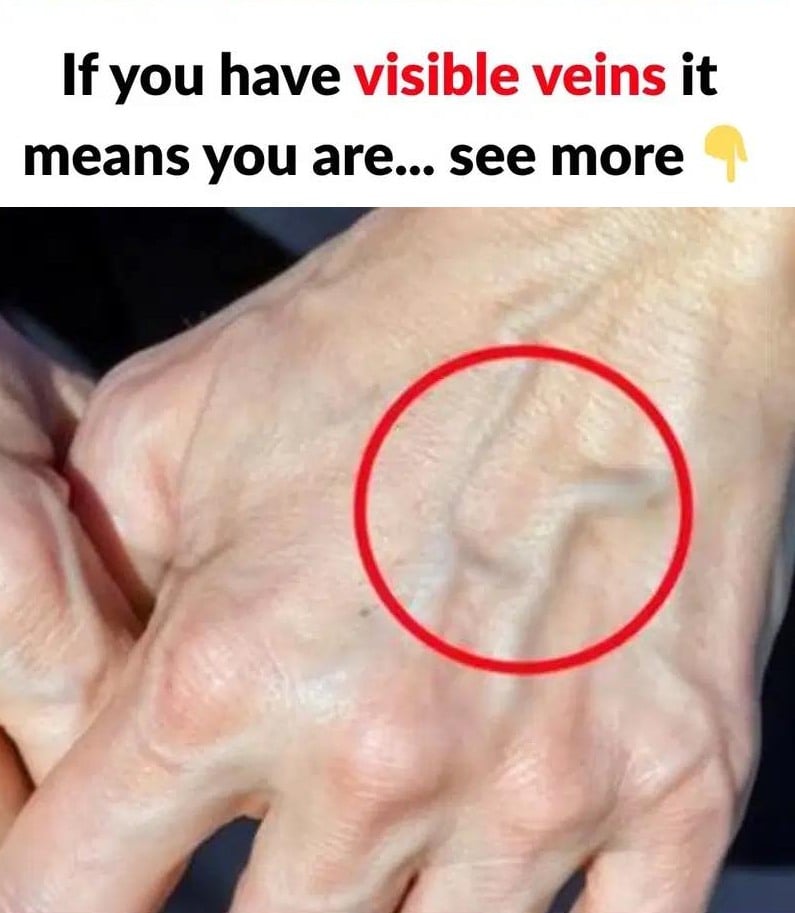Have you ever looked in the mirror and suddenly noticed a web of veins prominent on your hands, arms, legs, or even your chest, bright and unmistakably visible where they never were before? It’s a common phenomenon for many people, especially as they get older, but it can also appear unexpectedly at any age, often sparking curiosity or concern. While these new veins are often harmless and natural, they can sometimes be signs of underlying health conditions that require attention. Understanding why veins become more prominent can help you distinguish between normal physiological changes and potential health risks, encouraging proactive health management.
For most people, visible veins are simply part of the aging process. As we grow older, our skin gradually loses elasticity, becomes thinner, and less effective at hiding the network of blood vessels beneath the surface. This natural thinning allows veins that were once hidden to become more apparent. It’s a process that occurs gradually, and for many, it’s a sign of aging’s inevitable influence—not necessarily a health concern. However, the timeline and degree of vein visibility can vary greatly based on genetics and individual skin characteristics.
One of the most common contributors to the appearance of new veins is a reduction in body fat. When fat loss occurs — through dieting, exercise, or other health changes — the layer of fat that normally covers and conceals veins becomes much thinner. This is especially noticeable in the limbs and torso, where superficial veins are closer to the skin’s surface. For athletes, bodybuilders, or those on weight loss journeys, the increased visibility of veins, often called “vascularity,” is often seen as a sign of fitness and low body fat. But for others, sudden vein prominence can indicate a loss of subcutaneous fat due to aging or health issues.
Exercise and weight lifting are also key factors in the appearance of veins. When you engage in physical activity, especially strength training, your muscles require more blood flow to sustain effort and facilitate recovery. This increased blood flow causes veins to swell and become temporarily more prominent, as the body pushes more oxygen-rich blood through them. Over time, consistent training can cause muscles to grow and push veins closer to the skin’s surface, making them more visible even at rest. This is often viewed as a sign of a healthy, active lifestyle; however, in some cases, excessive or abrupt increases in vascularity might be linked to underlying health concerns like high blood pressure.
Temperature variations play a role too. During hot weather, your body works hard to cool itself, and one of the ways it does this is by dilating veins—widening them—to increase blood flow to the skin’s surface and release heat. This temporary change in vein size is usually harmless but can make veins appear more prominent. That’s why you might notice more visible veins in your arms and legs on a hot day, especially during outdoor activities or exercise. Once the temperature drops or you cool down, your veins typically contract and become less noticeable.
As we age, our skin’s structure continues to change. The production of collagen decreases, skin loses its firmness, and elasticity diminishes. These changes cause the skin to thin further and make underlying structures—including veins—more visible. It’s a natural part of the aging process, but it’s also associated with other health conditions, such as vascular diseases, that may cause chronic vein enlargement, varicose veins, or even varicosities. The gradual appearance of veins can serve as a visual cue that the body’s circulatory system is undergoing changes—some benign and others requiring medical attention.
Hormonal factors are another significant influence. During pregnancy, menopause, or when undergoing hormone therapy, fluctuations in hormone levels can affect blood vessel dilation and circulation. These hormonal shifts can cause veins that were previously hidden to become more prominent. Increased blood volume during pregnancy, for example, causes veins in the legs and pelvis to swell. Conversely, menopause can weaken vessel walls, contributing to visible veins or spider veins in various parts of the body.
In some cases, more prominent veins might signal circulatory issues, venous insufficiency, or other vascular conditions. If veins are accompanied by symptoms like pain, swelling, skin discoloration, or numbness, a healthcare professional should be consulted. Underlying vascular diseases can sometimes lead to serious complications if left untreated, such as blood clots or chronic venous insufficiency. Therefore, sudden or persistent changes in vein appearance should be evaluated to rule out these possibilities.
What can you do if you notice new or increased visibility of veins? A good starting point is to assess your overall health and lifestyle. Maintaining a healthy weight, staying active, and avoiding prolonged periods of standing or sitting can help minimize the appearance of problematic veins. Wearing compression stockings can support circulation, especially for those prone to varicose veins or swelling.
It’s also beneficial to protect your skin from UV rays, which can weaken blood vessel walls and exacerbate vein visibility. For those concerned about the appearance of veins or their potential health implications, consulting a healthcare professional—such as a vascular specialist—can provide guidance. Some conditions may require medical interventions, such


